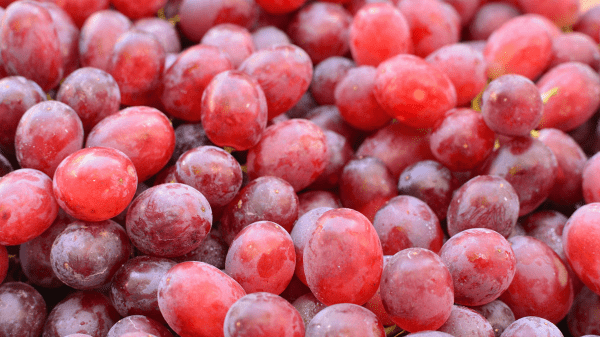World production of table grapes reached 27,898,000 tons in the 2022/2023 campaign, showing an increase of 4.4 percent compared to the 26,712,000 tons registered in the previous campaign (2021/2022), as reported by Agraria, using the report, “A different horizon,” carried out by the market research company Fluctuante, with figures from USDA.

According to this source, in the 2022/2023 campaign the largest table grape producing country globally was China with a production of 12,750,000 tons, showing an increase of 6.4 percent compared to the 11,980,000 tons of the campaign previous. The Asian giant had 45.7 percent of the total global production in the 2022/2023 campaign.
India follows with 2,850,000 tons, reflecting a contraction of 1.72 percent versus the 2,900,000 tons of the previous campaign, and represented 10.2 percent of the total. Turkey was in third place with 2,220,000 tons, an increase of 19.5 percent compared to the 1,857,000 tons of the previous campaign and accounted for 8 percent of the total.
Brazil with 1,748,000 tons (same production as in the previous campaign) and Uzbekistan with 1,695,000 tons (same production as in the previous campaign) were positioned in fourth and fifth place, respectively. The first participated with 6.3 percent and the second with 6.1 percent of the total.
In the sixth spot was Egypt with 1,560,000 tons, reflecting a growth of 6.1 percent compared to the 1,470,000 tons of the 2021/2022 campaign, concentrating 5.6 percent of the total. The European Union follows with 1,546,000 tons, observing an increase of 8.7 percent versus the 1,422,000 tons of the previous campaign, representing 5.5 percent of the total.
The United States, with 811,000 tons, showed a drop of 1.8 percent compared to the 826,000 tons reached in the previous campaign, participating with 2.9 percent of the total.
Peru with 766,000 tons in the 2022/2023 campaign, registered an increase of 7.4 percent versus the 713,000 tons of the previous campaign, contributing 2.7 percent of the total.
Closing the top ten is Chile with 656,000 tons, showing a reduction of 17.3 percent compared to the 793,000 tons of the previous campaign, representing 2.4 percent of the total. Other countries added 1,296,000 tons, showing a decrease of .9 percent compared to the 1,308,000 tons of the 2021/2022 campaign, concentrating 4.7 percent of the total.
Exports
Regarding the world’s export of table grapes, it reached 3,706,000 tons in the 2022/2023 campaign, reflecting a drop of 1 percent compared to the 3,740 ,000 tons exported in the 2021/2022 campaign.
Peru led world exports of table grapes in the 2022/2023 campaign with 593,000 tons, showing an increase of 10.4 percent compared to the 537,000 tons shipped in the previous campaign. The country concentrated 16 percent of global exports of this fruit.
Chile was the second world exporter of table grapes with 497,000 tons, showing a contraction of 18.3 percent compared to the 608,000 tons shipped in the previous campaign, participating with 13.4 percent of the total.
They are followed by China with 389,000 tons (increase of 10.8 percent compared to the previous campaign), South Africa 285,000 tons (decrease of 15.2 percent), India with 282,000 tons (increase of 2.6 percent), the United States with 247,000 tons (decrease of 4.3 percent), Turkey with 227,000 tons. (decrease of 14 percent), Mexico with 209,000 tons (increase of 6.6 percent), European Union with 173,000 tons (same as the previous campaign) and Egypt with 170,000 tons (increase of 13.3 percent).
Imports
While in terms of imports, the United States was the main global buyer of table grapes in the 2022/2023 campaign with 746,000 tons, reflecting an increase of 4.6 percent versus the 713,000 tons acquired in the previous campaign. Its main suppliers were Chile, which participated with 40 percent of the total, Peru with 32 percent, Mexico with 26 percent, and others with 2 percent.
Next is the European Union, which imported 573,000 tons, observing a reduction of 5.1 percent compared to the 604,000 tons registered in the previous campaign. Its main suppliers were South Africa with 20 percent of the total, Italy with 19 percent of the total, Spain with 12 percent, Peru with 9 percent and others with 40 percent.
Other importing countries are: Russia with 409,000 tons (increase of 7.6 percent), United Kingdom with 258,000 tons (decrease of 4.8 percent), Canada with 178,000 tons (decrease of 3.3 percent), China with 175,000 tons (decrease of 3.3 percent), Vietnam with 141,000 tons (increase of 42.4 percent), Thailand with 136,000 tons (increase of 32 percent), Hong Kong with 116,000 tons (decrease of 2.5 percent), and Indonesia with 105,000 (increase of 5 percent).



